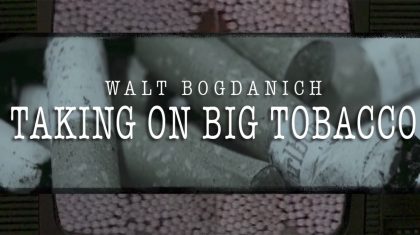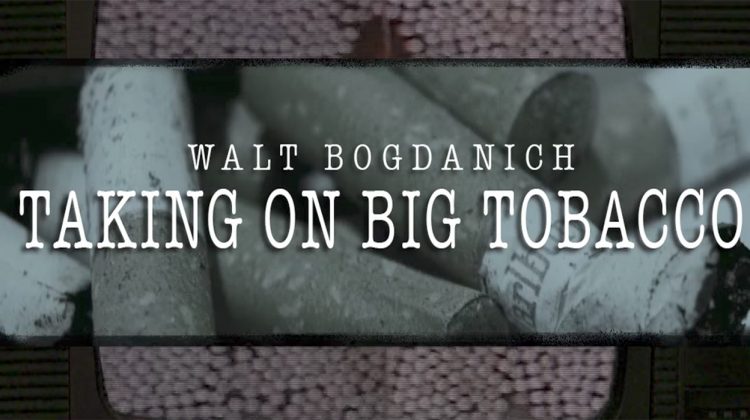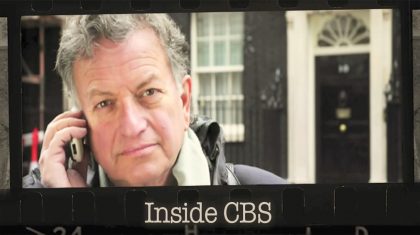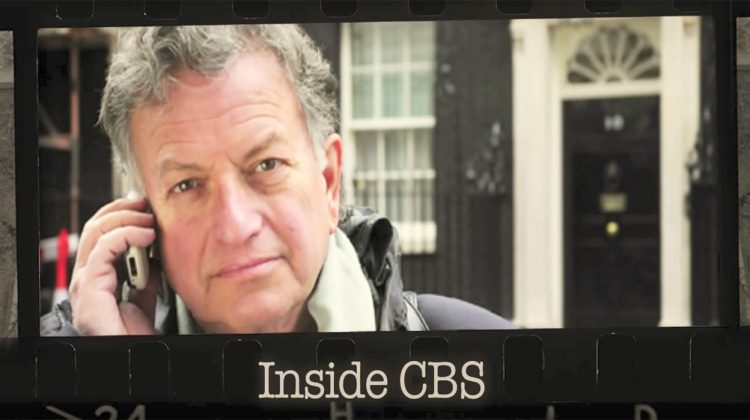While journalists serve as watchdogs against government corruption, many are more reluctant to report on corporate misdeeds. Since many major news organizations are funded by corporate sponsors, editors tend to balk at the idea of exposing a major contributor. But when journalists do expose corporate power, they do a great public service.
As a reporter for The Wall Street Journal, Walt Bogdanich reported on major tobacco companies adding addictive nicotine to their cigarettes. Later, as a reporter for The New York Times, Bogdanich won multiple Pulitzers for exposing problems with corporate railroad safety policies and the import of dangerous chemicals from China. Washington Post reporter Morton Mintz uncovered how thalidomide, a drug that helped women with nausea during pregnancy, also caused birth defects.
Videos
New York Times reporter Walt Bogdanich talks about Philip Morris' $10 billion lawsuit against him and the American Broadcasting Companies for his reporting on how tobacco companies add nicotine to cigarettes.
Share
The following URL links directly to the video or page.
Copy and paste the code into your website to embed this video.
Morton Mintz recalls reporting on thalidomide, a drug that helped women with nausea during pregnancy, but caused deformities in their unborn children. His reporting revealed that the drug maker had applied pressure to officials of the Food and Drug Administration for quick approval to the lucrative U.S. market.
Tags
Share
The following URL links directly to the video or page.
Copy and paste the code into your website to embed this video.
Donald Barlett and James Steele say that most journalists are too reluctant to report on corporate power.
Tags
Share
The following URL links directly to the video or page.
Copy and paste the code into your website to embed this video.
Walt Bogdanich talks about his investigation into the safety record of the railroad industry.
Tags
Share
The following URL links directly to the video or page.
Copy and paste the code into your website to embed this video.
Historical Timeline
Click on individual events to expand items one by one, or click the expand all button to view the entire contents of the timeline.
1929
- ‘Torches Of Freedom’
-
March 31, 1929
The American Tobacco Company attempts to eliminate the taboo against women smoking in public by paying women to march in New York’s Easter parade while openly smoking cigarettes. Edward Bernays, one of the earliest corporate public relations specialists and a nephew of Sigmund Freud, tells the women to call their cigarettes “torches of freedom,” tying them to the then-burgeoning feminist movement. The stunt generates media attention and is one of the earliest examples of the tobacco industry using PR to manipulate perceptions of their product.1
1938
- Longevity Study
-
March 4, 1938
Science magazine publishes a study by Raymond Pearl of the Johns Hopkins School of Public Health looking at the life spans of 6,813 men, roughly half of whom smoked. Pearl’s study shows that the life span of a smoker is significantly shorter than that of a nonsmoker. It is believed to be one of the earliest attempts to quantify the negative health consequences of tobacco use.2
1939
- First Cancer Link
-
January 1, 1939
(exact month and day unknown) German scientist and Nazi party member Franz H. Müller publishes the first evidence of the link between tobacco and lung cancer in the leading German cancer journal, Zeitschrift für Krebsforschung. Somewhat ironically, the Nazis were among the first to wage a public campaign against tobacco use, as they believed its carcinogenic properties watered down the purity of the Aryan race.3
1941
- Media Supress Study
-
January 13, 1941
George Seldes, publisher of the independent newspaper In Fact, reveals that a major scientific study on tobacco and longevity published years earlier had been suppressed by the country’s newspapers, many of which relied heavily on tobacco advertising for revenue.4
1950
- More Cancer Evidence
-
September 30, 1950
The British Medical Journal publishes a study by A. Bradford Hill and Dr. Richard Doll which shows that heavy smokers are 50 times more likely to contract lung cancer than nonsmokers.5 This is one of five scientific studies linking smoking to lung cancer published in 1950.
1951
- Thirteen Studies
-
January 1, 1951
(exact month and day unknown) Thirteen case-control studies comparing smoking rates among smokers and nonsmokers are released.6
1952
- Digest Report
-
December 1, 1952
(exact day unknown) Readers Digest publishes “Cancer by the Carton,” an article detailing much of the new scientific findings on the health effects of smoking. Because it didn’t accept advertising at that time, the Digest was one of the few news outlets willing to publish negative stories about the tobacco industry.7
1953
- BBB Criticism
-
February 1, 1953
(exact day unknown) The national Better Business Bureau sends a letter to tobacco company Liggett & Myers criticizing its advertising campaign that cast doubt on the weight of scientific evidence showing smoking is harmful. “Although cigarette advertising, as such, has been widely and justly criticized in recent years, we believe your current advertising represents a particularly flagrant disregard of the public interest,” the Bureau writes.8
- Tobacco CEO Meeting
-
December 14, 1953
Paul Hahn, president of the American Tobacco Company, convenes a meeting in New York of the heads of all major U.S. tobacco companies to develop a unified, industry-wide PR strategy to respond to the increasing weight of scientific evidence against tobacco.9
1954
- ‘A Frank Statement’
-
January 4, 1954
Weeks after their meeting in New York, the tobacco companies take out a full-page ad in 448 U.S. newspapers, titled, “A Frank Statement to Cigarette Smokers.” “We do not believe that any serious medical research, even though its results are inconclusive should be disregarded or lightly dismissed,” the ad reads. It announces the creation of the seemingly scientific Tobacco Industry Research Committee.10 In a confidential memo released years later, the chief counsel to tobacco company Brown & Williamson admits that the committee “was conceived as a public relations gesture.”11
- Major Longevity Study
-
June 21, 1954
Daniel Horn and E. Cuyler Hammond of the American Cancer Society present the findings of their new study at the annual meeting of the American Medical Association. Their long-term study of more than 180,000 men is the most extensive examination to date of smoking and longevity, and that smokers in their early to mid-60s are more than twice as likely to die than their non-smoking counterparts.12
1961
- Letter To The President
-
June 1, 1961
The American Cancer Society, the American Public Health Association, the American Heart Association and the National Tuberculosis Association send a letter to President John F. Kennedy urging the formation of a presidential commission to study the “widespread implications of the tobacco problem.”13
1962
- Stark Warning
-
March 7, 1962
Britain’s Royal College of Physicians, the leading medical society in the U.K., issues a report clearly indicating that smoking causes lung cancer and bronchitis. The report also states that smoking probably contributes to cardiovascular disease.14 The British report is one of the most unambiguous scientific statements yet that tobacco is harmful.
- Surgeon General’s Committee
-
June 7, 1962
In response to the presidential letter from public-health associations, U.S. Surgeon General Luther Terry establishes an expert committee to perform a comprehensive review of all data on smoking and health.15
1964
- Landmark Report
-
January 11, 1964
Terry issues the results of his committee’s findings in a landmark report, “Smoking and Health: Report of the Advisory Committee to the Surgeon General.” The report states that smoking increased mortality by 70 percent; that heavy smokers were 20 times more likely to develop lung cancer than nonsmokers; that smoking is correlated with emphysema; and that smoking during pregnancy reduces the weight of newborns. The report is issued on a Saturday to minimize its impact on the stock market, but as Terry recalls, it “hit the country like a bombshell. It was front-page news and a lead story on every radio and television station in the United States and many abroad.”1617
1965
- Cigarette Labeling
-
July 27, 1965
In response to Terry’s report, Congress passes the Federal Cigarette Labeling and Advertising Act. It requires a warning to be placed on all packs of cigarettes warning consumers about their negative health effects.18 This is the first time any such warning has been mandated by the federal government on any commercial product.
1969
- ‘Doubt Is Our Product’
-
January 1, 1969
(exact month and day unknown) An executive with the tobacco company Brown & Williamson gives a presentation to his fellow executives on PR strategies for overcoming the tsunami of bad press that has hit the industry. The confidential minutes of the presentation were later unearthed during legal discovery, and the document is believed by some to be a “smoking gun.”19 “Doubt is our product since it is the best means of competing with the ‘body of fact’ that exists in the mind of the general public,” the executive states. “Doubt is also the limit of our ‘product.’ Unfortunately, we cannot take a position directly opposing the anti-cigarette forces and say that cigarettes are a contributor to good health. No information that we have supports such a claim.”20
1972
- ‘Creating Doubt’
-
May 1, 1972
Fred Panzer, an executive at the industry trade group The Tobacco Institute, writes a confidential memo that, when unearthed years later during litigation, will be seen as more proof that the industry knew its products were harmful even as it publicly denied this. Referring to the industry’s modus operandi of waging PR battles against claims that tobacco is harmful, Panzer writes that this “has always been a holding strategy, consisting of creating doubt about the health charge without actually denying it.”21
1985
- Aspen Ban
-
August 26, 1985
The City Council in the resort town of Aspen, Colorado, passes a measure that outlaws smoking in public places, including restaurants and bars, if a separately ventilated area specifically for smokers isn’t provided. The measure makes Aspen the first in the country to enact a smoking ban.22 In the following years, hundreds of towns and several states enact bans on smoking in public places.
1988
- Legal Defenses
-
January 3, 1988
The CBS News program "60 Minutes" airs a story revealing that the tobacco industry has spent approximately $100 million defending itself against lawsuits from smokers. Part of that $100 million went toward paying private investigators to look into the personal lives of the plaintiffs in these cases. Laurence Tisch, the chair of the CBS Network who also owns the Lorillard Tobacco Company, refuses to appear on camera in the story.37
1993
- Secondhand Smoke
-
January 7, 1993
After a contentious two-year delay, the EPA issues a report stating that secondhand smoke can cause cancer and increase the risk of respiratory disease in children.23 Because the EPA doesn’t have regulatory authority over cigarette smoke, the report has little impact at first. But as its findings are confirmed, it will lead to a sweeping change in the way cities regulate smoking in public.
1994
- Libel Lawsuit
-
March 24, 1994
The Philip Morris Company files a $10 billion libel lawsuit against reporter John Martin, producer Walter Bogdanich and the ABC network over a story that aired a few several weeks previously on ABC’s "Day One" program. The story claimed the tobacco industry adds nicotine to its cigarettes to make them more addictive.24 (In truth, the tobacco companies do not add nicotine to cigarettes but, rather, are aware of how to remove nicotine and opt not to.25) Later this same day, ABC shelves a documentary by producer Martin Koughan about the tobacco industry, even though it had already been cleared by the network’s editorial and legal departments. The documentary never airs.2627
- Tobacco Hearings
-
April 14, 1994
The CEOs of the seven largest U.S. tobacco companies are called to testify before the House Energy & Commerce Subcommittee on Health & the Environment. The chairman of the subcommittee, Rep. Henry Waxman, D-Calif., is incredulous that the executives still refuse to acknowledge their products are harmful — even as they admit they wouldn’t want their own children to smoke.28 The hearing is a public-relations debacle for the tobacco industry and leads the Justice Department to launch perjury investigations against the executives.29
1995
- ABC Apology
-
August 21, 1995
ABC settles its lawsuit with Philip Morris, even though its own lawyers believe the network has a better-than-even chance of winning. The settlement comes as the owner of ABC, Capital Cities, is looking to sell the network to the Disney Company, a deal that would eventually net its top executives millions of dollars. ABC issues a formal apology to Philip Morris and, as part of the settlement, Diane Sawyer reads the apology during halftime of "Monday Night Football." Bogdanich and Martin refuse to sign the apology. Four days later, Philip Morris takes out a full-page ad titled “Apology Accepted” in approximately 700 newspapers.30
- Pressure At CBS
-
September 12, 1995
Lawyers with the CBS network tell producers of "60 Minutes" to stop reporting a story about tobacco whistleblower Jeffery Wigand. The lawyers say Wigand signed a nondisclosure agreement with his former tobacco-industry employer, and if CBS broadcasts its interview with Wigand, the company might face a billion-dollar lawsuit for “tortious interference” — persuading someone to break a legal contract. Wigand’s statements in his interview may open Laurence Tisch’s son, Andrew, the CEO of Lorillard, to perjury charges for his testimony before Congress a year earlier.31
- Self-Censorship
-
November 12, 1995
"60 Minutes" airs an edited version of the Wigand interview that does not include many of his most explosive allegations.32 The producer of "60 Minutes," Don Hewitt, acknowledges publicly that ABC’s recent experiences with Philip Morris played a role in the decision not to air the full interview.33 The New York Times editorial board slams the decision, writing, “The traditions of Edward R. Murrow and '60 Minutes' itself were diluted in the process.”34
1996
- Wigand Deposition
-
January 26, 1996
The Wall Street Journal obtains a copy of a confidential deposition Jeffery Wigand gave a few months earlier, in which he repeated many of the same statements that were edited out of his interview with "60 Minutes." The deposition was part of a trial in which the state of Mississippi was suing tobacco companies for the costs of providing Medicare coverage to smokers. After obtaining the deposition, the Journal posts a full, unedited copy of it on its website.35
- Full Interview
-
February 4, 1996
Much of the information that caused "60 Minutes" to initially censor the Wigand interview has now been made public by The Wall Street Journal. As a result, the program decides to air the full version of its interview with Wigand.36
1998
- Tobacco Settlement
-
November 13, 1998
The four major U.S. tobacco companies reach a huge settlement with dozens of attorneys general in a lawsuit brought by all 50 states seeking to recover the Medicare costs of treating smokers.38 The suit requires the companies to pay out $246 billion through 2025. Part of that money will go toward anti-tobacco advertising, research into the harmful effects of tobacco, and maintaining an online archive of previously confidential and, in some cases, incriminating, industry documents.39 The online archive is at San Francisco State.
1999
- RICO Lawsuit
-
September 22, 1999
The Justice Department uses federal RICO statutes (Racketeer Influenced and Corrupt Organizations Act), initially enacted to combat organized crime, to file one of the largest civil lawsuits in history against the tobacco companies. The suit accuses the companies of “conspiring since the 1950s to defraud and mislead the public.”40
- The Insider
-
November 5, 1999
Based on the controversy surrounding the CBS News "60 Minutes" television interview with Jeffery Wigand, the film "The Insider" is released. It stars Al Pacino as "60 Minutes" producer Lowell Bergman and Russell Crowe as Wigand. The film goes on to be nominated for seven Academy Awards.41
2006
- Court Ruling
-
August 17, 2006
U.S. District Court Judge Gladys Kessler rules in favor of the Justice Department’s RICO lawsuit seven years after it was initially filed. In her ruling, she writes that the tobacco industry “survives, and profits, from selling a highly addictive product which causes diseases that lead to a staggering number of deaths per year, an immeasurable amount of human suffering and economic loss, and a profound burden on our national health care system. Defendants have known many of these facts for at least 50 years or more. Despite that knowledge, they have consistently, repeatedly, and with enormous skill and sophistication, denied these facts to the public, to the government and to the public health community. Moreover, in order to sustain the economic viability of their companies, Defendants have denied that they marketed and advertised their products to children under the age of 18 and to young people between the ages of 18 and 21 in order to ensure an adequate supply of ‘replacement smokers,’ as older ones fall by the wayside through death, illness, or cessation of smoking. In short, defendants have marketed and sold their lethal products with zeal, with deception, with a single-minded focus on their financial success, and without regard for the human tragedy or social costs that success exacted.”42 Despite this decision, the tobacco industry is delighted “the court did not award unjustified and extraordinarily expensive monetary penalties that had been sought by the government." 43 Indeed, tobacco stock prices went up immediately after her ruling. 44 Judge Kessler had concluded that an earlier Court of Appeals ruling prevented her from fining the industries for billions of billions of dollars in damages sought by the Justice Department.
2009
- FDA Authority
-
June 22, 2009
President Barack Obama signs into law the Family Smoking Prevention and Tobacco Control Act, which gives the Food and Drug Administration authority to regulate tobacco products for the first time in U.S. history.45 According to the World Health Organization, 100 million people around the world died from smoking-related illnesses in the 20th century and it is estimated there will be a billion smoking-related deaths this century.46 From the late 1970s, with Americans smoking less, the industry began an aggressive export strategy, aided and abetted by U.S. trade officials in both Republican and Democratic administrations, from Jimmy Carter to Barack Obama, prying open foreign markets of younger, replacement smokers.
Recommended References
BOOKS
- Brandt, Allan M. The Cigarette Century: The Rise, Fall and Deadly Persistence of the Product that Defined America. New York: Basic Books, 2007.
- Glantz, Stanton A. et. al. The Cigarette Papers. Berkeley, CA: University of California Press, 1996.
- Kessler, David. A Question of Intent: A Great American Battle With a Deadly Industry. New York: Public Affairs, 2001.
- Kluger, Richard. Ashes to Ashes: America’s Hundred-Year Cigarette War, the Public Health, and the Unabashed Triumph of Philip Morris. New York: Random House, 1996.
- Michaels, David. Doubt Is Their Product: How Industry’s Assault on Science Threatens Your Health. Oxford, England: Oxford University Press, 2008.
ENDNOTES
- 1 Brandt, Allan M. The Cigarette Century: The Rise, Fall and Deadly Persistence of the Product that Defined America. New York: Basic Books, 2007. Pp. 80-84.
- 2 Tobacco Smoking and Longevity Study - Science Magazine
- 3 Proctor, Robert N. The Nazi War on Cancer. Princeton, NJ: Princeton University Press, 1999. Pp. 194.
- 4 George Seldes Obituary - The (London) Independent
- 5 Smoking and Carcinoma of the Lung - British Medical Journal
- 6 Michaels, David. Doubt Is Their Product: How Industry’s Assault on Science Threatens Your Health. Oxford, England: Oxford University Press, 2008. Pp. 5.
- 7 Norr, Roy. "The Reader's Digest Breaks The Silence On Cigarettes And Death." Muckraking! The Journalism That Changed America. Ed. Judith Serrin and William Serrin. New York: The New Press, 2002. 54-56. Print. Rpt. of "Cancer by the Carton." Reader's Digest Dec. 1952: n. pag.
- 8 Brandt, pp. 163.
- 9 Ibid., pp. 165.
- 10 "A Frank Statement" ad - Tobacco Legacy Documents Library
- 11 Brandt, pp 233.
- 12 The Relationship Between Human Smoking Habits and Death Rates - JAMA
- 13 Surgeon General's Report - NIH Pp. 7.
- 14 Profile of Surgeon Genearal Luther Terry - U.S. Department of Health and Human Services
- 15 Ibid. Pp. 8.
- 16 Summary of the Surgeon General's Report - NIH
- 17 Sullivan, Walter. “Cigarettes Peril Health, U.S. Report Concludes; ‘Remedial Action’ Urged.” The New York Times. Jan. 12, 1964.
- 18 Cigarette Labelling and Advertising Act - U.S. House of Representatives
- 19 Michaels, Pp. 11.
- 20 Tobacco Industry Memo - Tobacco Legacy Documents Library Pp. 4-5.
- 21 The Roper Proposal - Tobacco Legacy Documents Library Pp. 1.
- 22 “Aspen City Council Passes Tough Anti-Smoking Law.” Associated Press. Aug. 27, 1985.
- 23 Kenworthy, Tom. “Secondhand Smoke Peril Affirmed; EPA Move to Endorse Report on Cigarettes May Affect Workplace.” The Washington Post, A1. Jan. 6, 1993.
- 24 Hall, Jane. “Philip Morris Sues ABC For $10 Billion.” Los Angeles Times. March 25, 1994.
- 25 Shepard, Alicia, C. “Up In Smoke.” AJR. Nov. 1995.
- 26 Ledbetter, James. “Up In Smoke.” The Village Voice. Sept. 12, 1995.
- 27 Gunther, Marc. “TV called spineless for axing tobacco programs.” The Toronto Star. D7. Nov. 14, 1995.
- 28 Inside the Tobacco Deal Timeline - Frontline
- 29 Levin, Myron. “All 7 Tobacco Industry Executives in Perjury Probe Have Quit The Industry.” Los Angeles Times. June 1, 1996.
- 30 Shepard.
- 31 Brenner, Marie. “The Man Who Knew Too Much.” Vanity Fair. May 1996.
- 32 Ibid.
- 33 Carter, Bill. “’60 Minutes’ Ordered To Pull Interview In Tobacco Report.” The New York Times. Nov. 9, 1995.
- 34 “Self-Censorship at CBS.” New York Times. Nov. 12, 1995.
- 35 Wigand Deposition - Wall Street Journal
- 36 Wallace, Mike. “Jeffery Wigand Ph. D.” 60 Minutes. Bergman, Lowell, producer. Feb. 4, 1996.
- 37 Wallace, Mike. “Tobacco on Trial.” 60 Minutes. Lewis, Charles and Bonin, Richard, producers. Jan. 3, 1998.
- 38 LeDuc, Daniel. “Md. Mulls Joining U.S. Tobacco Settlement or Gambling With Lawsuit.” The Washington Post. Nov. 14, 1998.
- 39 Tobacco Master Settlement Agreement - National Association of Attorneys General
- 40 Lacey, Marc. “Tobacco Industry Accused of Fraud in Lawsuit by U.S.” The New York Times. A1. Sept. 23, 1999.
- 41 The Insider - Internet Movie Database
- 42 Judge's Opinion - U.S. Department of Justice
- 43 Cauvin, Henri E. and Stein, Rob. “Big Tobacco Lied To Public, Judge Says: Industry Avoids Huge Penalties but Is Ordered to Correct False Advertising.” The Washington Post. A1. Aug. 18, 2006.
- 44 “What Were They Smoking?” Wall Street Journal. A10. Aug. 19, 2006.
- 45 Family Smoking Prevention and Tobacco Control and Federal Retirement Reform Act - Government Printing Office
- 46 Brant, pp. 487.

 Taking on Big Tobacco
Taking on Big Tobacco  Taking on Big Tobacco
Taking on Big Tobacco  Inside CBS
Inside CBS  Inside CBS
Inside CBS